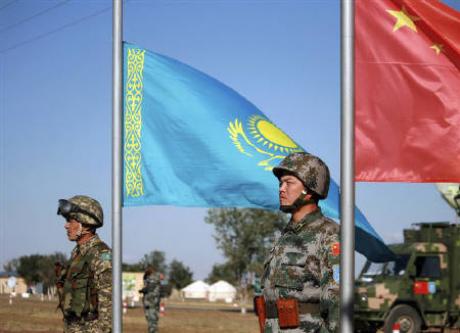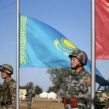
PLA Displays Network-Centric Capabilities in Peace Mission 2010
Publication: Eurasia Daily Monitor Volume: 7 Issue: 180
By:

Force elements, planning, scenario and the conduct of the Shanghai Cooperation Organization (SCO) Peace Mission 2010, staged in Kazakhstan from September 9 to 25, were largely similar to previous exercises (EDM, September 28). That is apart from the Chinese People’s Liberation Army (PLA)’s contribution, which was significant for a number of reasons including the geopolitical context of instability in Kyrgyzstan and the recent violence in Tajikistan. Intervention during a crisis in Central Asia appears more plausible, though it remains unclear whether the Collective Security Treaty Organization (CSTO) or the SCO might offer a viable multilateral framework in such circumstances, or if a bilateral agreement would be preferred resulting in a unilateral operation. Following the failure of the CSTO to intervene in Kyrgyzstan to restore order after the request made by the interim Kyrgyz government in June, many have questioned the organization’s actual capability to offer credible stabilization options. Peace Mission 2010 showcased the SCO’s potential, if consensus were achieved, to provide an alternative and the scenario involved requesting UN Security Council backing before commencing operations.
Uzbekistan’s refusal to participate in the exercise left the other five SCO members to uphold the multilateral organization’s security credentials. Apart from predictable political statements concerning the SCO’s need to combat the “three evils” of terrorism, separatism and extremism, the exercise concentrated on an anti-terrorist theme, displaying unity of action and implausible institutional equality. However, the level of manpower was less than Peace Mission 2007 (6,500 personnel in 2007, compared with 5,000 this year), while much of the equipment revealed little difference; unsurprising in terms of the weak Tajik and Kyrgyz armed forces, though puzzling especially since the Kazakh military claims to make substantial progress towards its modernization. Despite the Russian military reform, the “new look” force elements appeared decidedly dated. It is clear, however, that the PLA grouping and equipment eclipsed the other four SCO members (Xinhua, September 25).
In this context, Major-General Meng Guoping, the deputy commander of the PLA’s participating forces, highlighted five key advances during Peace Mission 2010, all bolstering an image of the PLA’s power projection capabilities. The equipment used by the PLA featured during the National Day celebrations in 2009, were Mode-99 tanks, 122 howitzer carriers, the 425 integrated air defense system, and the J-10 fighter aircraft as well as command shelters. Moreover, PLA spokesmen emphasized that all the equipment was domestically produced. Significantly, the design and assembly of the equipment was aimed at fitting a combat system to facilitate network-centric operations, linked by ground and air command platforms united in an information system. General Meng Guoping specifically used the phrase “system of systems” in referring to the deployment of network-centric assets (Zhongguo Xinwen She, September 21).
PLA involvement in Peace Mission exercises has also evolved to compensate for the difficulties of the language barriers, honing training in an unfamiliar environment and switching to field commands. In the PLA field camps formed for Peace Mission 2010, tents, beds and shower camps were all transported and built by the Chinese. Efforts were made to improve command and control during the exercise, extending it from the strategic level to the tactical level. Joint and coordinated action was stressed, for instance involving the Chinese air force (PLAAF) with their Russian and Kazakh counterparts: two Kazakh MiG-29 fighters were joined by three H-6 PLAAF aircraft to form an escort force, while helicopter assets from China, Russia and Kazakhstan formed a unified strike force. Equally, attention was given to securing PLA communications channels during the exercise, presumably rehearsing anti-jamming measures (Zhongguo Xinwen She, September 21).
Moreover, the high-profile PLAAF demonstration of strategic air power, involving fighters and bombers conducting non-stop flights to simulate high-precision strikes in Kazakhstan, before returning to their bases in Urumqi were “safeguarded” by adding mid-air refueling to ensure their success. PLAAF senior officers stated that they could have conducted the mission without refueling (Zhongguo Xinwen She, September 21, Jiefangjun Bao, September 23). As the PLAAF develops its air combat group, integrating combat, early warning command, long-range strikes, escort and cover, and in-flight refueling, Peace Mission 2010 was confidently used to demonstrate advances made towards carrying out independent long-range precision strikes. The PLAAF was evidently practicing offensive air operations in an informatized network-centric context. The underlying message appeared to be that the PLA stands out among the SCO forces for its growing power projection capabilities (Zhongguo Xinwen She, September 21).
Since the other members of the SCO currently lack network-centric capabilities, it is revealing that China chose to demonstrate these power projection levels during a multilateral exercise. The reasons underlying this show of genuine military strength are rooted in the dynamic tension that exists within the competitive and cooperative Sino-Russian strategic partnership. In the aftermath of the global financial crisis and China’s emergence as the second strongest world economic power, many perceive that Beijing is willing to raise its defense profile internationally. Equally, during Stride 2009, the PLA rehearsed intervention to a depth of 2,000 kilometers, indicating that China might be prepared to intervene in either Russia or Central Asia in defense of its national interests. The Russian operational-strategic exercise, Vostok 2010 (June 29 to July 8) in the Siberian and Far East Military Districts, to which PLA observers were invited, was partly in response to Stride 2009 (EDM, July 14). Vostok 2010 was used as an opportunity to profile the “new look” and exaggerate Russian progress towards developing network-centric capabilities (still largely at a formative stage). Peace Mission 2010 reminded Moscow that Beijing actually possesses military capabilities currently lacking in the Russian conventional armed forces. China conveyed the message in the exercise that it has its disposal the capability to intervene “cleanly” in Central Asia, without the need for temporary or permanent regional basing, probably under a multilateral umbrella. Yet, the decision to showcase these capabilities may also reflect recognition in Beijing that Moscow is serious about its military reform. Moreover, in the future, there might conceivably be joint Sino-Russian network-centric operations in Central Asia, to mitigate the emergence of a resurgent regional Taliban threat in the aftermath of an International Security Assistance Force (ISAF) withdrawal from Afghanistan.




